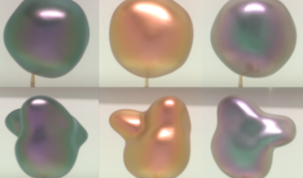Iridescent objects and animals are quite mesmerizing to look at, since they feature multiple intense colors, whose distribution can vary quite dramatically as a function of viewing angle. These properties make them a particularly interesting and unique stimulus to experimentally investigate the factors that contribute to single color impressions of multi-colored objects. Our stimuli were 3D printed shapes of varying complexity that were coated with three different types of iridescent paint. For each shape-color combination, participants performed single- and multi-color matches for different views of the stationary object, as well as single color matches for a corresponding rotating stimulus. In the multi-color matching task, participants subsequently rated the size of the surface area on the object that was covered by the match-identified color. Results show that single-color appearance of iridescent objects varied with shape complexity, view, and object motion. Moreover, hue similarity of color settings in the multi-color match task best predicted singlecolor appearance, however this predictor was weaker for predicting single color matches in the motion condition. Taken together our findings suggest that the single-color appearance of iridescent objects may be modulated by chromatic factors, spatial-relations and the characteristic dynamics of color changes that are typical for this type of material.
